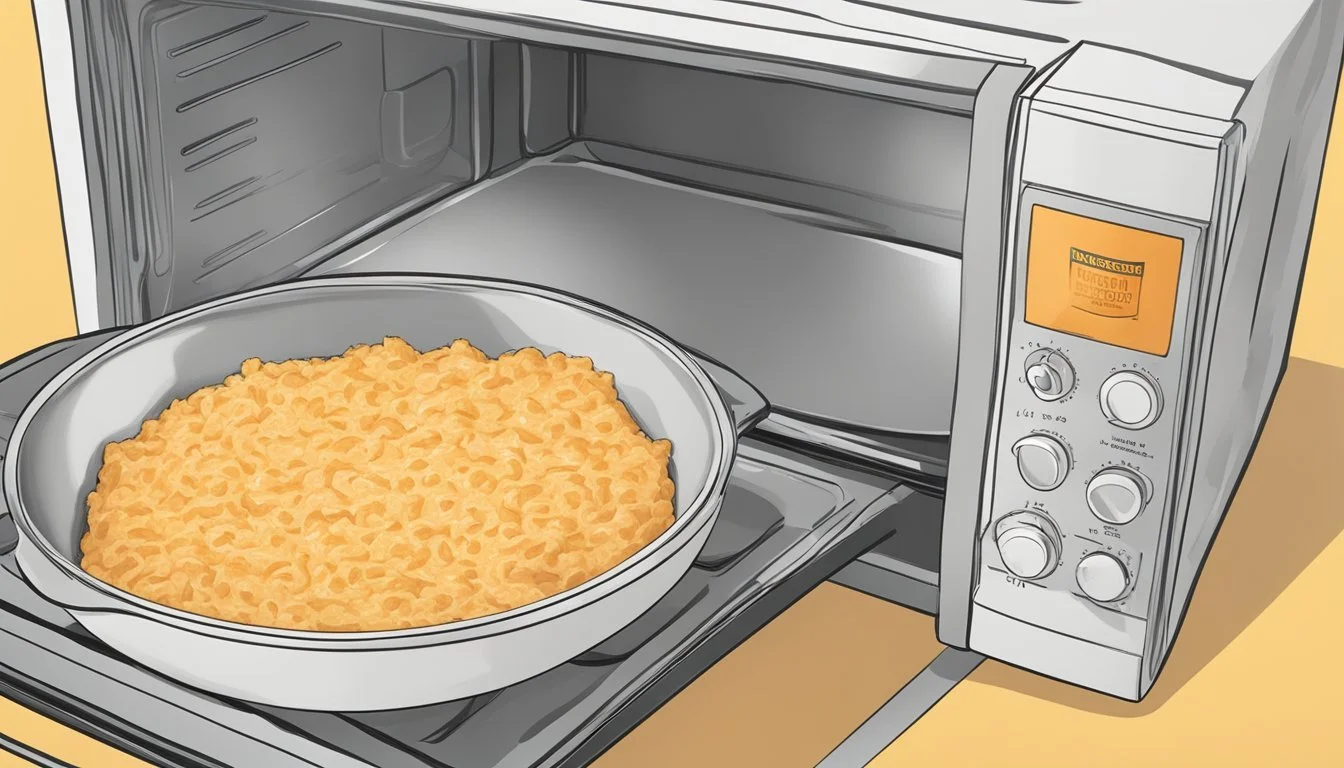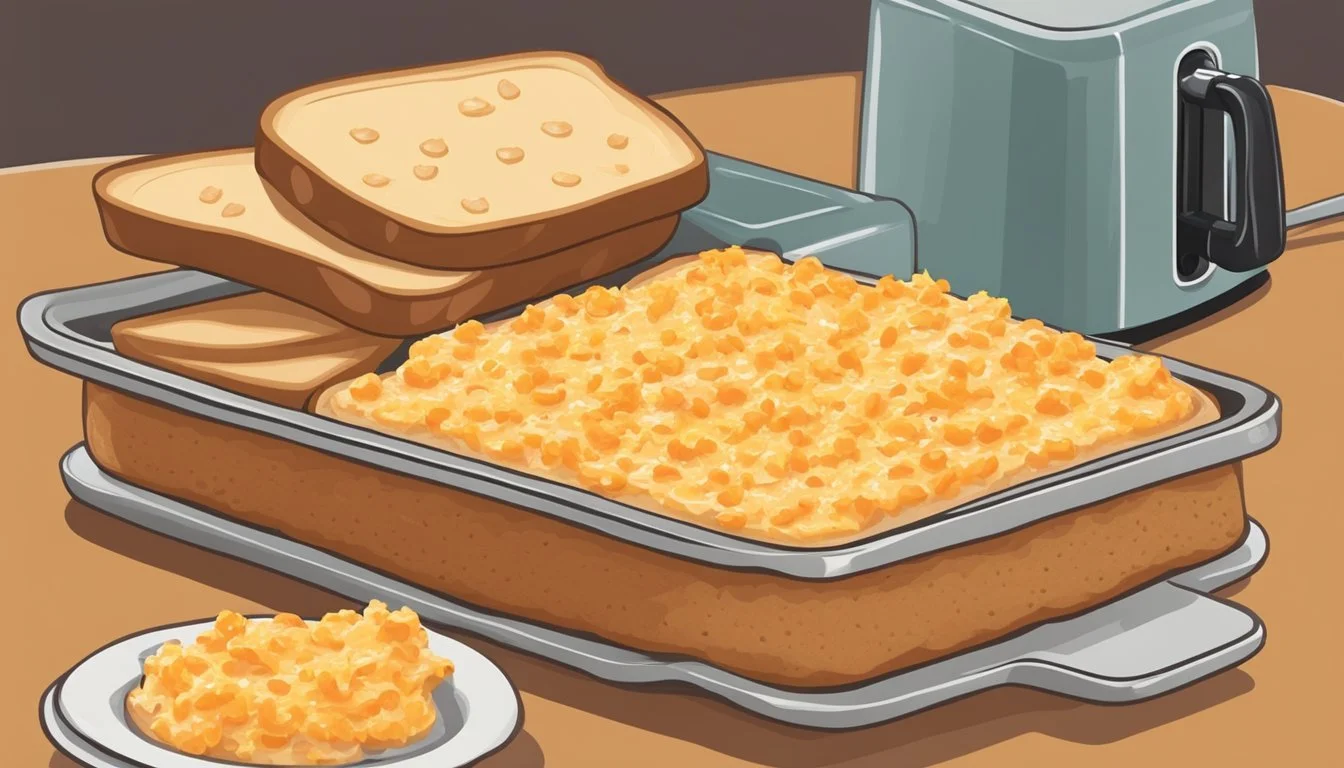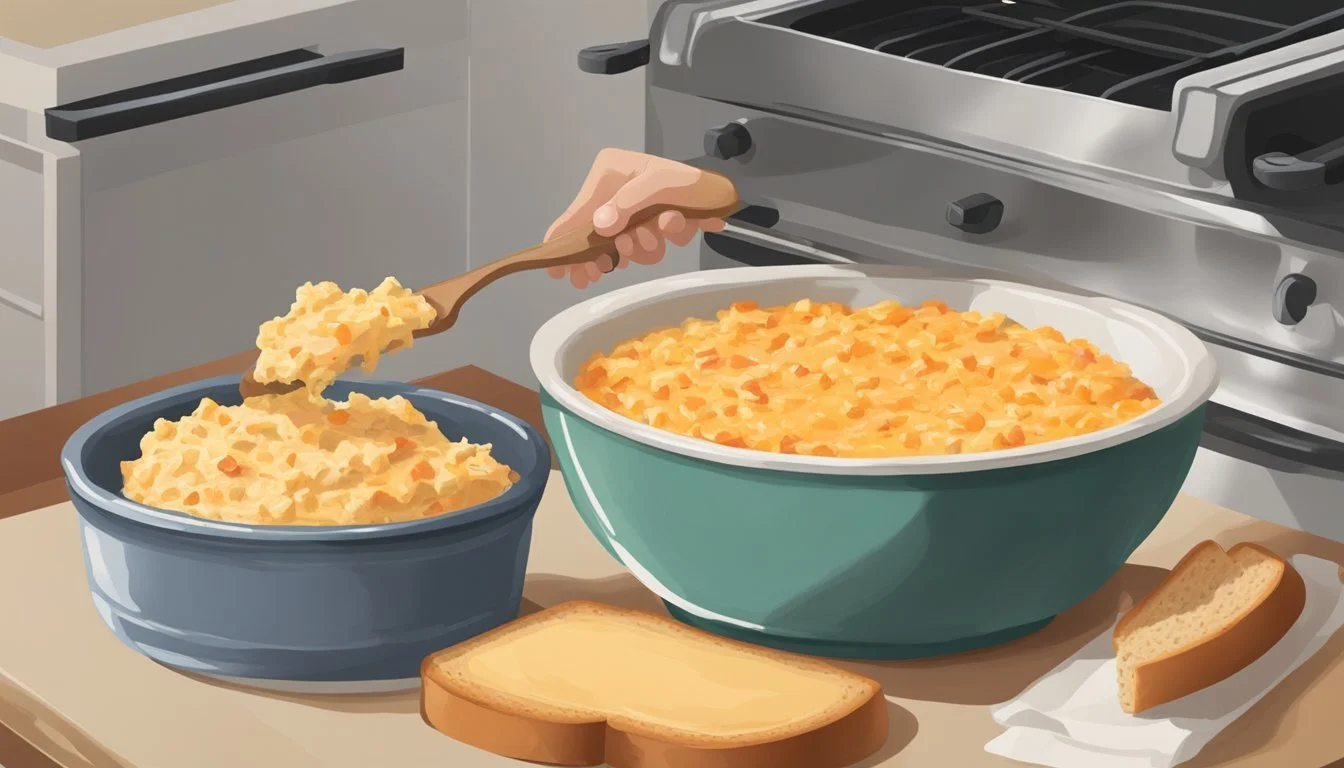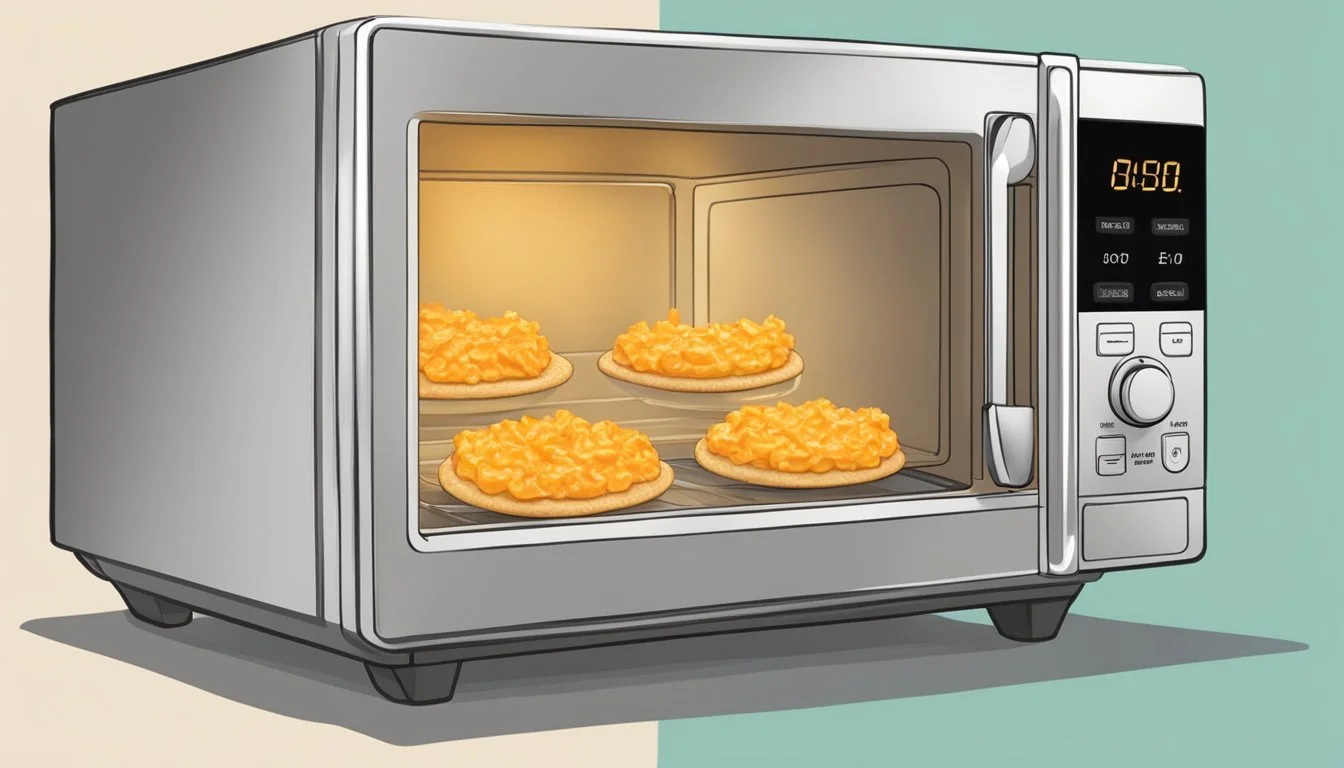Best Way to Reheat Pimento Cheese
Maintaining Creaminess and Spreadability
Pimento cheese (What wine goes well with cheese?), with its creamy texture and bold flavors, is a beloved Southern staple that has found its way into kitchens across the country. Ideal for spreading on crackers or sandwiches, it's enjoyed by many for its perfect blend of cheddar cheese, pimento peppers, and mayonnaise. However, maintaining that ideal consistency can be challenging once the pimento cheese has been refrigerated, as it tends to solidify and lose some of its spreadability. Reheating pimento cheese to restore its creamy texture is a delicate process that warrants careful attention to ensure the dip remains as enjoyable as when it was first made.
Many might not consider the reheating process of pimento cheese, presuming that simply warming it quickly will suffice. Yet, the key to reviving its creamy nature lies in a gentle reheating method that prevents separation of the ingredients. Reheated too hastily or at too high of a temperature, it risks becoming greasy or lumpy. By using a strategic approach to reheating, one can preserve the flavorful integrity and creamy texture of pimento cheese, ensuring it’s just as spreadable and delicious as intended.
Understanding Pimento Cheese
Pimento cheese is a classic Southern culinary delight, often enjoyed as a spread or dip. It boasts a rich flavor profile that is creamy with a slightly sweet and tangy taste, achieved from the use of sharp cheddar cheese and pimentos. A staple cheese spread in Southern cuisine, pimento cheese is not only versatile but also customizable according to personal taste preferences.
Key Ingredients:
Sharp Cheddar Cheese: Provides a robust flavor foundation.
Cream Cheese: Adds a smooth and creamy texture.
Mayonnaise: Enhances spreadability and adds creaminess.
Pimentos: Small, sweet cherry peppers that contribute a distinct sweet pepper flavor.
Typical Uses:
As a dip for crackers or vegetables
Spread on sandwiches or burgers
Filler for appetizers or stuffed peppers
Many homemade pimento cheese recipes include a base of cheddar cheese, mayonnaise, and pimentos, often enriched with cream cheese for additional creaminess. The ingredients are combined until the desired consistency is reached, creating a spreadable mixture that can be adapted with spices or other additions, like jalapeños for heat, or garlic powder for zest.
The flavor of pimento cheese is anchored by the sharp cheddar cheese, lending a profound cheese taste that is balanced by the creamy and tangy character of the mayonnaise and cream cheese. The pimentos provide a sweet and slightly tangy element that complements the cheese's richness. When preparing pimento cheese, one should be attentive to the balance of flavors, ensuring the spread maintains its beloved creamy and spreadable texture.
The Perfect Pimento Cheese Recipe
Crafting the ideal pimento cheese begins with a selection of premium ingredients and follows a meticulous mixing process. Below are the carefully articulated steps and tips to ensure a creamy, flavorful spread each time.
Selecting Quality Ingredients
Sharp Cheddar: The cheese should be freshly grated off the block for better melting and integration.
Mayonnaise: Opt for a full-fat, high-quality mayo to maintain the creamy texture.
Pimentos: Use well-drained, chopped pimentos for a pop of flavor and color.
Seasoning: A pinch of salt is essential for enhancing all the other flavors.
Step-by-Step Mixing Instructions
Combine the freshly grated sharp cheddar with a dollop of creamy mayo in a large bowl.
Mix in the chopped pimentos carefully, to avoid mashing the cheese.
Stir the mixture together until the ingredients are evenly distributed.
Notes: The consistency should be creamy and spreadable; if it's too thick, a spoonful of reserved pimento liquid can help adjust it.
Flavor Enhancements and Variations
Seasoning: Elevate the flavors with a touch of garlic powder, onion powder, or a sprinkle of cayenne pepper.
Variations: One can add jalapeños or roasted peppers to introduce a new level of flavors.
Recipe Card Tip: Always let the pimento cheese rest in the refrigerator for a few hours before serving to allow the flavors to meld.
To Pin: Remember that the best pimento cheese is easily adaptable; one can adjust seasonings to taste.
Proper Storage Techniques
Proper storage is crucial for keeping pimento cheese creamy and spreadable. By storing pimento cheese correctly, one can extend its shelf life and preserve its flavor and texture.
Storing in the Fridge
Storing pimento cheese in the refrigerator is the best method to maintain its freshness for short-term use. Place the cheese in an airtight container to prevent it from drying out or absorbing odors from other foods. Ideally, one should keep the cheese chilled at a temperature between 35-45°F. When stored this way, pimento cheese can remain fresh for approximately one week.
Temperature: 35-45°F
Container: Airtight
Shelf Life: Up to 1 week
Freezing and Thawing Tips
For long-term storage, one may freeze pimento cheese, although it may slightly alter the texture upon thawing. Before freezing, ensure the cheese is placed in an airtight container to minimize exposure to air. When ready to use, thaw the cheese in the refrigerator rather than at room temperature to prevent any bacterial growth.
Method: Freeze in airtight container
Thawing: In the fridge, not at room temperature
Shelf Life: Up to 6 months
Before using either refrigerated or thawed pimento cheese, one should always drain any excess liquid to maintain its creamy consistency.
Reheating for Optimal Creaminess
Reheating pimento cheese to retain its creamy and spreadable texture requires gentle heat and attention to detail. Each method outlined below offers tips to ensure a smooth result.
Microwave Tips
To achieve creaminess in a microwave, one should heat the pimento cheese in short intervals at a low power setting. Stirring between each interval is crucial to maintain an even temperature and prevent hotspots, which can cause the cheese to separate and oil out. For best results:
Heat: Set the microwave to 50% power.
Duration: Warm in 15-second intervals.
Stir: Stir gently after each interval to assess texture.
Oven Method
Using an oven to reheat pimento cheese can preserve its spreadability if done correctly. Preheat the oven to a low temperature to avoid overheating, which could cause separation. Here's a succinct guide:
Temperature: 275°F (135°C) for gradual heating.
Container: Place pimento cheese in an oven-safe dish with a lid to trap moisture.
Time: Check every few minutes until desired temperature and texture are achieved.
Stovetop Technique
The stovetop allows for direct control over the heat, which can help one maintain the cheese's creamy consistency. A double boiler setup is ideal to distribute heat evenly without scorching.
Heat: Use low heat throughout the process.
Equipment: Utilize a double boiler or a heatproof bowl over a pot of simmering water.
Consistency: Stir occasionally, watching for a lusciously smooth texture that's perfect for spreading.
Serving Suggestions
When reheated properly, pimento cheese retains its creamy, spreadable consistency, which pairs excellently with a variety of foods. Here are specific ways to serve it for the best experience.
Pairing with Crackers and Veggies
Crackers: Choose plain or seasoned crackers as a base for the pimento cheese. A crisp, neutral cracker complements the creamy cheese without overpowering its flavor.
Veggies: Fresh, crunchy vegetables like celery sticks or cucumber slices make a refreshing counterpart to the rich pimento cheese.
Incorporating into Sandwiches and More
Sandwiches: Pimento cheese becomes a gourmet filling for a grilled cheese sandwich, adding extra flavor to this classic comfort food.
Snacks and Appetizers: A dollop of warm pimento cheese can transform a simple snack of chips or a baked potato into a delightful treat.
Burgers: Upgrading a burger with a spoonful of creamy pimento cheese makes for a satisfying and indulgent meal.
For breakfast options, reheated pimento cheese can even be creatively used with eggs to craft flavorful omelets or savory scrambled egg dishes. Whether as an appetizer or a main dish component, reheated pimento cheese offers versatility and pleasing taste.
Health and Nutrition Insights
When considering the best way to reheat pimento cheese to maintain its creaminess and spreadability, it's essential to also consider the health and nutritional aspects of the cheese. Pimento cheese is traditionally high in fat, making it a calorie-dense food. However, the exact nutritional content can vary based on the ingredients used.
Nutrition Information:
Calories: A 1 oz serving typically contains around 106 calories.
Fat: It comprises a significant amount of fat, as roughly 75% of the calories come from fat.
Making a healthier version of pimento cheese is possible by modifying ingredients. Low-calorie and high-protein versions can be made, which may reduce the calorie content to about 89 calories for 1/3 cup, while also incorporating 7.4g of protein. Here's a breakdown:
Component Details Calories 89 per 1/3 cup (approx.) Protein 7.4g per serving Carbohydrates Low, exact amount varies Spreadability Affected by reheating method
To ensure that reheating doesn't compromise the nutritional value, one should reheat pimento cheese gently, avoiding high temperatures which can cause separation and increase the oiliness, changing the taste and potentially adding more calories if extra ingredients are used to return creaminess.
Substituting ingredients for lower-calorie or higher-protein options can also impact how pimento cheese responds to reheating. A more health-conscious version may include low-fat cheeses or yogurt to sustain a creamy texture while being mindful of overall caloric intake.
When reheating pimento cheese, one's goal should be to bring it to a temperature that makes it pleasantly spreadable without compromising its texture and nutritional integrity.
Creative Uses Beyond a Dip or Spread
While pimento cheese delights as a dip or spread, its culinary potential stretches far beyond these applications. Its creamy texture and bold flavor profile make it an ideal candidate for inventive baked goods and meal additions.
Pimento Cheese in Baked Goods
Savory Cheese Bread: Incorporating pimento cheese into a bread dough results in a savory loaf radiant with flavor. Mixing in additional ingredients such as parmesan and onion powder can enhance the depth of taste. A typical bread with pimento cheese can be baked for about 30 minutes, producing a treat enjoyable both warm and at room temperature.
Biscuits or Scones: By adding pimento cheese to biscuit or scone recipes, bakers transform these classic pastries into cheesy, piquant versions that are ideal accompaniments for meals or as stand-alone snacks.
Innovative Meal Additions
Stuffed Proteins: Stuff chicken breasts or pork chops (What wine goes well with pork chops?) with pimento cheese for a melty, flavorsome filling. The cheese becomes gooey once heated, oozing into every cut of the meat and elevating the dish with its tangy taste.
Pimento Cheese Grilled Cheese: Revolutionize the traditional grilled cheese by using pimento cheese. Spread it between two slices of bread and grill until the bread is golden and the cheese has reached a luscious, creamy consistency.
Answering Common Questions
This section addresses frequently asked questions on ingredient substitutions and provides tips to ensure a perfect consistency when reheating pimento cheese.
FAQs on Ingredient Substitutions
When it comes to making pimento cheese, certain ingredients may be substituted to cater to taste preferences or dietary restrictions. Readers often question whether they can use alternatives without compromising the flavor or texture of the cheese.
Cayenne Pepper: A common query is about substituting cayenne pepper to adjust the spiciness. One can use red pepper flakes or a small amount of chili powder as alternatives, keeping in mind that these substitutions may slightly alter the final flavor profile.
Bell Pepper: Inquiries about replacing pimento peppers, which are a type of cherry pepper, often arise. While pimento peppers offer a distinct taste, if needed, roasted red bell peppers can be used as a substitute. Make sure they are well-drained to avoid excess moisture.
Jalapeños: If one desires more heat, adding diced jalapeños is recommended. However, this should be done judiciously to maintain balance.
Consistency Adjustments: Some reviews mention using different types of cheese to achieve a smoother texture. For those questioning cheese types, one may use a block of cream cheese as it melts well and contributes to a creamy consistency when reheated.
Tips for Perfect Consistency
Achieving the perfect smooth consistency when reheating pimento cheese is crucial for enjoyment, and commenters often seek advice on this matter.
Heating Method: Reheat refrigerated cheese dip in a microwave-safe bowl, covering it with a microwave-safe lid or plastic wrap. It's important to leave room for steam to escape.
Intervals: Heat on a high power setting at 30-second intervals, removing it from the microwave to stir thoroughly after each. This process prevents overheating and helps maintain a smooth texture.
Texture Check: Reviews indicate that texture can make or break the pimento cheese experience. If the mixture appears too thick, a small amount of milk can be stirred in to reach desired spreadability.
Storage: If the consistency is too runny after cooling, storing the pimento cheese in the refrigerator can help it stiffen up. Conversely, allowing it to reach room temperature before serving ensures a spreadable texture.
By considering these substitution tips and reheating advice, one can ensure their pimento cheese is both delicious and perfectly creamy.
Closing Thoughts and Additional Resources
When reheating pimento cheese to maintain its creamy and spreadable consistency, one should carefully consider the method chosen. Gentle heat is key; too much heat can cause the cheese to separate and become oily rather than creamy. For those seeking more comprehensive information on pimento cheese variations, storage, and serving suggestions, they may consult authoritative culinary websites or cookbooks specializing in Southern cuisine.
Additional resources for enthusiasts include:
Cookbooks: These often provide not only recipes but also insights into the history and tradition behind dishes like pimento cheese.
Cooking Classes: Local culinary schools or community workshops may offer sessions focused on cheese preparation and preservation.
Websites and Blogs: Food bloggers often share personal tips and tricks related to specific recipes, which can be relevant when handling delicate spreads.
In pursuit of authoritative resources, one might turn to established food networks or culinary professionals known for their expertise in traditional American cuisine. These sources are typically backed by a wealth of experience and provide information that can be trusted.
Remember, the best practices for reheating pimento cheese are as follows:
Use low heat when reheating.
Stir the cheese frequently to maintain an even temperature.
Avoid microwaving if possible, as it can unevenly heat and spoil the texture.
By adhering to these guidelines, the pimento cheese can be restored to its optimal state, ready to be enjoyed as if freshly made.









